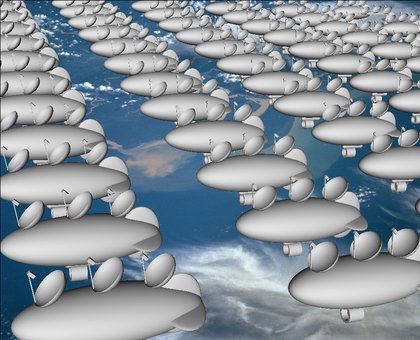Stratospheric solar array
This page contains rough details of a concept that I have been brewing recently that might have some potential — or this idea may trigger other thoughts at least.
The basic concept is to have a vast constellation of hydrogen blimps (aerostats) floating in the stratosphere collecting the sun's energy and transmitting it down to a base station at sea.
Contents
Advantages of being in the stratosphere
- In permanent sunshine
- Above the weather and strong winds
- Out of the way of air traffic and wildlife
- The hours of sunshine are extended due to the altitude
- Less attenuation of sunlight due to being above 2/3 of the atmosphere
- Does not take up any land space
If the array is far out in the ocean then there is no shadow being cast where people live and no-one will be able to see it. Even where there is shadow it will be no different to shadow from cloud except that it will be more fragmented due to the spacing of the blimps.
Parabolic solar receivers
Photovoltaic cells are still very expensive, especially ones with high efficiencies (>20%). It may be better to use parabolic reflectors aiming the light onto a thermal converter such as a stirling engine. These have been developed at Sandia National Laboratories in the US, the EU's SolAir project and by companies such as Stirling Energy Systems and Infinia.
Stirling Energy Systems say that using their system "a solar farm 100 miles by 100 miles could satisfy 100% of the America’s annual electrical needs".
All existing solar thermal collectors designs would be far too heavy to carry on a blimp, but possible lightweight versions are outlined below.
Aerostat configuration
There might be a number of ways of achieving this:
1) Large blimps with rows of parabolic reflectors and stirling engine combinations along the top surface. It may be possible to make very lightweight parabolic dishes using aluminised mylar sheets held across a lightweight frame (or curved inflated ribs on the back surface) or alternatively the parabolic dishes could be an inflatable flattened spheroid with one half being a transparent material and the other half being reflective on the inside surface - internal pressure and the shape of the surface material could give the correct parabolic shape. Blimps would have to have counterweights underneath to compensate for the weight on the top surface - propeller units for the blimp might be enough. Not very aerodynamic and small collecting area for size of blimp.
2) Blimps carry just the parabolic reflectors underneath (or on top or held between other blimps) which point focused sunlight at a separate thermal receiver perhaps held by a much larger aerostat which gathers energy from many reflectors. Blimps would be in herds comprising of many reflector carriers and motherships.
3) The envelopes of the blimps themselves could be the inflatable spheroid dishes mentioned towards the end of option 1 above. Weights with adjustable positioning are hung underneath to adjust the angle of the reflective surface inside the envelope so as to point in the right direction. Blimps could simply be reflectors pointing at a receiving blimp or each blimp has stirling engine at their focal point. If there are significant aerodynamic issues of having a flattened spheroid angled at the sun, the blimp could instead be spherical and clear with a parabolic reflector held inside. Spherical airships are being developed by 21st Century Airships.

Station keeping ideas
- Could be tethered to ground with ultrafine, ultra strong fibre. Not as desirable as a tetherless as could get in the way of trans-ocean traffic and might be vulnerable to storms, although cables could be reeled in with warning. There are parts of the world where storms are infrequent. The advantage over a tetherless array is there are no energy losses due to station keeping and energy conversion processes at transmitter and reciever. High altitude tethers are also featured in the jet-stream sky windmill concept.
- Divert some of the received energy to power ducted propellers or other kind of thruster and virtually anchor using GPS positioning
- Stay in same general region by varying altitude to take advantage of different wind directions at different altitudes similar to the way hot air balloons can have some control of their direction of travel.
- Tug aerostats connected to a number of reflector carriers that are joined by lightweight compression struts
Energy transfer
From sky to sea
- Depends on configuration of collectors. Cables connecting each blimp receiving direct solar energy, then mothership blimps carrying high voltage cable down to floating ground station.
- Or use principle from solar power satellite and generate relatively low energy density microwave beam directed at a rectenna floating on the sea surface.
From sea to land
- Undersea cable back to land
- Or use energy to split seawater (salty and good for electrolysis) and gather the hydrogen. Hydrogen then either highly compressed or absorbed in a metal hydride or liquefied and transported by tanker (hydrogen powered) or pipeline back to shore perhaps enabling the much anticipated hydrogen economy.
Considerations
- Energy cost of station keeping (alternatively could be tethered)
- Energy cost and ability to aim the reflectors accurately at the thermal receivers
- Having a system that reliably keeps focal points of reflectors away from flammable blimp envelopes!
- Cable or microwave beam hazard depending on method of final energy transfer. Cable could be made radar reflective. Beam could be of low enough energy density to be harmless to passing people and creatures. Beam can also turn off autonomously based on radar readings if necessary.
- Designing blimps capable of stratospheric altitude while carrying necessary payload
- Losses of hydrogen from envelopes - it is hard to contain hydrogen without leakage. Helium does not leak so readily but is more expensive and is a limited resource.
- Creating lightweight parabolic reflectors with accurate enough surfaces to focus sunlight efficiently
- Aerodynamics bearing in mind the solar collection equipment
- Area of solar collection surface vs. weight
- Energy return on investment (EROI). Will there be a significant energy return when taking into account manufacture of blimps and thermal conversion equipment, power transmission, energy conversions, station keeping, production of hydrogen for aerostat envelopes.
Other thoughts
- If the sea-based receiving station generates hydrogen as a fuel (or energy carrier) for hydrogen economy, it could of course also be used for filling the blimp envelopes.
- If blimps are black (if the design allows) it would increase buoyancy - hot helium creates more lift than cold helium.
- A variation of the stratospheric solar array power station might be as a dedicated desalination plant, using all the energy collected to convert seawater into freshwater. It is a good fit as the marine base station is sitting on the ocean (plenty of water) and the industrial infrastructure can all be off-shore and out of sight. Fresh water could be pumped via a pipeline back to shore or taken via tanker. Availability of enough fresh water in various parts of the world is a very significant issue today.
- Envelopes of blimps could be biopolymer films grown in moulds, using nutrients in sea or perhaps CO2 and water to create hydrocarbon raw material. This also might mean that blimps are biodegradable.
- The 'cost' and complexity may make this concept not seem economically viable today, however if the whole scheme was designed to employ closed-loop automation principles so once it has been commissioned it could self-sustain and maintain using the resources of the sea and sea-bed to create what it needs to run continuously, with little or no human intervention, and the energy plant (and the autonomous maintenance systems) is developed by people using open collaborative design then a project of this scale might become possible. Assuming there are no fundamental flaws in the concept, feasibility with projects like this is a matter of availability of material, energy and intelligence and not necessarily our current notions of economics.
